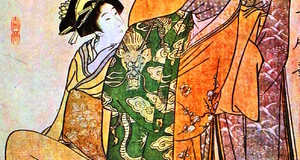|
Featured Article: Women in Meiji Japan: Exploring the Underclass of Japanese Industrialization
However, there was a presence of women like Kishida Toshiko, Fukuda Hideko, Shimizu Toyoko and Yajima Kajiko, who actively rallied for social reforms. The Tokyo Women’s Reform Society attacked the concubine system and prostitution and provided a deeper challenge to patriarchy. The TWRS did achieve mild success as it forced certain local governments into passing regulations regarding prostitution.
A popular way of protest among women was by changing their hairstyles and cropping their hair short—something unimaginable by Japanese standards of beauty at the time.
However, such “feminist” progressives enjoyed little success as a new civil code in 1898 formally reinforced the subordinate status of women in society, confining them to the household ( i.e.). Married women now had no economic independence or right to take independent legal action. The Meiji state began to show absolutist colors as such measures began to homogenize Japanese society, linking it with the political economy and its new structures.
However, the condition of the lower classes, the poor peasant women, rural laboring women, sex workers and the urban factory women remained largely similar throughout the first half of the 20th century. The Capitalist system worked its play in exploiting the weakest of the weak sections in society—the women.
The massive industrial strength of which Japan today is proud and which the world admires with awe, came at a huge cost. The incredibly large force of laboring young girls who lived a life of exploitation and subjugation throughout the adolescence of Modern Japan remain largely ignored in the discourse of global development today. As suicide rates begin climbing in contemporary Japan, the Japanese have started looking into the recent past. The study of labor has gained pace with great works on women laborers coming up in Japan. It is however, most unfortunate that it took so long to notice!
Misiko Hane echoes the sentiment of those who see the cost that had to be paid for Japan’s modernization:
The harsh conditions and exploitation that existed in Japan’s factories cannot be excused with the argument that the workers would have been worse off as peasants in the villages. Paens are sung about the great success of Japan’s modernization since the Meiji Restoration, but to what avail modernization if, instead of improving the lot of the vast majority of people, it only increases the wealth and comfort of a small elite at the top?
Tragedy can never truly be expressed in academic accounts and works. Yet it is the task of the historic academia to bring to the fore these tragedies that remain unseen; to give a voice to those who could not be heard. And only in doing that can the subaltern eventually speak for themselves, without requiring the microphone that the present academia has to offer.
Adams, R. J. Q. Arms and the Wizard. Lloyd Georgebut the Ministry of Munitions 1915-1916 (1978, Cassell &Co. Ltd., London).
Ahmed, A. K. N. The Basis of Japan’s Modernisation (August 13, 1988, pub. in Economic and Political Weekly, Vol. 23 No. 33).
Bayly, Christopher A. Birth of the Modern World 1780-1914: Global Connections and Comparisons (2004, Atlantic Publishers & Distributors).
Chakraborty, Tanika. Impact of Industrialisation on Relative Female Survival: Evidence from Trade Policies (2009).
Doak, Kevin M. A History of Nationalism in Japan: Placing the People (2007, Brill, Leiden).
Gordon, Andrew. A Modern History of Japan: From Tokugawa Times to the Present (2003, Oxford University Press, New York).
Hane, Misiko. Peasants, Rebels and Outcastes: the Underside of Modern Japan (2003, Rowman and Littlefield Publishers Inc., New York).
Hobsbawm, Eric. The Age of Empire1875-1914 and The Age of Extremes 1914-1991(2012, Abacus).
Lowe, Norman Mastering Modern World History (1997, Macmillan Publishers India).
Notes from Prof. Amit Kumar’s lectures (at Hans Raj College, University of Delhi, 2015).
Tipton, Elise K. Modern Japan: A Social and Political History (2002, Routledge Publications, London).
- Japanese economy grew at a rate of 5% p.a. in the 1880s. Compare this to the average growth rate of the global economy which stood at 3.5% p.a. in the same time period.
- This is not a new development in Japan in the sense that such importance to travel and study was present in Japan throughout the period of the Tempo Crisis and the decline of the Tokugawa Shogunate. A huge number of Japanese educated young men (and in a few cases even women) travelled to Europe and America during the 18th and 19th centuries. They brought back with them ideas like Libertarianism, Justice, Equality, Democracy, Socialism, Communism, Anarchism and even Feminism; concepts of a Parliament, Nationalist economy, Statehood, Empire and Colonialism, too found a way into Japanese intellectual circles. This again is not very surprising as in this period there is a growing European and American presence in Japan. The West brought with it its ideas and encouraged the Japanese to take them up. The Japanese had little opposition to new ideas owing to their Confucian legacy of long dialogue and a rather democratic debate culture among the scholars.
- It is these Daimyos that later emerged as private capitalists or zaibatsu.
- They were the ones who were given land ownership after the assessment of land was conducted by the Emperor in 1868.
- In 1872, the first railway line was laid, with about 40% of the State’s investment. In 1880, about 5000 miles of Railway existed in Japan. But by 1900, Japanese railways expanded so rapidly that 34,000 miles of tracks ran throughout the Japanese islands. This is a clear symptom of the incredibly fast expansion of Japanese economy
- Tipton, Elise K. Modern Japan: A Social and Political History (2002)
- Lockwood, Economic Development of Japan, p. 33
- Adams, R.J.Q. Arms and the Wizard. Lloyd Georgebut the Ministry of Munitions 1915 – 1916 (1978, Cassell & Co. Ltd., London)
- This was seen as an expense incurred by the company.
- This is lower than the average wage of a mill worker in India during the same period.
- Hane, MisikoPeasants, Rebels and Outcastes: The Underside of Modern Japan (2003)
- The daily diet of a factory worker included rice, bean paste soup, pickles or tofu, and occasionally bits of fish.
- Remember that this is a period of great intellectual exchange between Japan and the West. A contingent of women was sent to San Francisco by the Meiji regime during this period. It was these women who, upon return from the USA, formed the early feminist groups in Japan.
- This stigma towards sex trade had long existed in Japan. However, there is plentiful evidence that sex trade existed long before the Meiji regime. Although, a huge industry like this needs regular clientele who pay hefty sums, in order for the trade to sustain, very little public recognition of the existence of this industry ever existed. Hence, despite the stigma the sex trade in Japan has long seen a tussle for recognition.
- These were common practices by the poor peasant families in the Tokugawa era to counter agrarian poverty, especially in the northern provinces.
- Chakraborty, Tanika Impact of Industrialisation on Relative Female Survival: Evidence from Trade Policies (2009)
- It is interesting to note that similar practices can be traced in almost all Asian countries during economic slumps. Especially India, where such a practice is more formal–the daughters are married off to the local moneylender or landlord in case of families faulting the repayment of loans.
- Much like the Tokugawa times.
- She was a politician and a newspaper editor.
- He was the leader of the Salvation Army–an organization that spoke against oppressive practices towards women.
- She was a pre-war feminist, who was deceived into prostitution during her early life in California, USA.
- Nolte, Sharton and Hastings, Sally The Meiji State’s Policy Toward Women, 1890-1910 (1991)
Adams, R. J. Q. Arms and the Wizard. Lloyd Georgebut the Ministry of Munitions 1915-1916 (1978, Cassell &Co. Ltd., London).
Ahmed, A. K. N. The Basis of Japan’s Modernisation (August 13, 1988, pub. in Economic and Political Weekly, Vol. 23 No. 33).
Bayly, Christopher A. Birth of the Modern World 1780-1914: Global Connections and Comparisons (2004, Atlantic Publishers & Distributors).
Chakraborty, Tanika. Impact of Industrialisation on Relative Female Survival: Evidence from Trade Policies (2009).
Doak, Kevin M. A History of Nationalism in Japan: Placing the People (2007, Brill, Leiden).
Gordon, Andrew. A Modern History of Japan: From Tokugawa Times to the Present (2003, Oxford University Press, New York).
Hane, Misiko. Peasants, Rebels and Outcastes: the Underside of Modern Japan (2003, Rowman and Littlefield Publishers Inc., New York).
Hobsbawm, Eric. The Age of Empire1875-1914 and The Age of Extremes 1914-1991(2012, Abacus).
Lowe, Norman Mastering Modern World History (1997, Macmillan Publishers India).
Notes from Prof. Amit Kumar’s lectures (at Hans Raj College, University of Delhi, 2015).
Tipton, Elise K. Modern Japan: A Social and Political History (2002, Routledge Publications, London).
Endnotes
- Japanese economy grew at a rate of 5% p.a. in the 1880s. Compare this to the average growth rate of the global economy which stood at 3.5% p.a. in the same time period.
- This is not a new development in Japan in the sense that such importance to travel and study was present in Japan throughout the period of the Tempo Crisis and the decline of the Tokugawa Shogunate. A huge number of Japanese educated young men (and in a few cases even women) travelled to Europe and America during the 18th and 19th centuries. They brought back with them ideas like Libertarianism, Justice, Equality, Democracy, Socialism, Communism, Anarchism and even Feminism; concepts of a Parliament, Nationalist economy, Statehood, Empire and Colonialism, too found a way into Japanese intellectual circles. This again is not very surprising as in this period there is a growing European and American presence in Japan. The West brought with it its ideas and encouraged the Japanese to take them up. The Japanese had little opposition to new ideas owing to their Confucian legacy of long dialogue and a rather democratic debate culture among the scholars.
- It is these Daimyos that later emerged as private capitalists or zaibatsu.
- They were the ones who were given land ownership after the assessment of land was conducted by the Emperor in 1868.
- In 1872, the first railway line was laid, with about 40% of the State’s investment. In 1880, about 5000 miles of Railway existed in Japan. But by 1900, Japanese railways expanded so rapidly that 34,000 miles of tracks ran throughout the Japanese islands. This is a clear symptom of the incredibly fast expansion of Japanese economy
- Tipton, Elise K. Modern Japan: A Social and Political History (2002)
- Lockwood, Economic Development of Japan, p. 33
- Adams, R.J.Q. Arms and the Wizard. Lloyd Georgebut the Ministry of Munitions 1915 – 1916 (1978, Cassell & Co. Ltd., London)
- This was seen as an expense incurred by the company.
- This is lower than the average wage of a mill worker in India during the same period.
- Hane, MisikoPeasants, Rebels and Outcastes: The Underside of Modern Japan (2003)
- The daily diet of a factory worker included rice, bean paste soup, pickles or tofu, and occasionally bits of fish.
- Remember that this is a period of great intellectual exchange between Japan and the West. A contingent of women was sent to San Francisco by the Meiji regime during this period. It was these women who, upon return from the USA, formed the early feminist groups in Japan.
- This stigma towards sex trade had long existed in Japan. However, there is plentiful evidence that sex trade existed long before the Meiji regime. Although, a huge industry like this needs regular clientele who pay hefty sums, in order for the trade to sustain, very little public recognition of the existence of this industry ever existed. Hence, despite the stigma the sex trade in Japan has long seen a tussle for recognition.
- These were common practices by the poor peasant families in the Tokugawa era to counter agrarian poverty, especially in the northern provinces.
- Chakraborty, Tanika Impact of Industrialisation on Relative Female Survival: Evidence from Trade Policies (2009)
- It is interesting to note that similar practices can be traced in almost all Asian countries during economic slumps. Especially India, where such a practice is more formal–the daughters are married off to the local moneylender or landlord in case of families faulting the repayment of loans.
- Much like the Tokugawa times.
- She was a politician and a newspaper editor.
- He was the leader of the Salvation Army–an organization that spoke against oppressive practices towards women.
- She was a pre-war feminist, who was deceived into prostitution during her early life in California, USA.
- Nolte, Sharton and Hastings, Sally The Meiji State’s Policy Toward Women, 1890-1910 (1991)
Suggested Reading from Inquiries Journal
The role of women in ancient Japan elicits inconsistencies due to different influences that were integrated at various time periods. The primary influence that contributed to these inconsistencies was religion. Integration of the two major religions of Japan, Shintoism and Buddhism, created a paradox for the female identity; altering... MORE»
Devastated by an economic collapse at the end of the 20th century, Japan’s economy entered a decade long period of stagnation. Now, Japan has found stable leadership, but attempts at new economic growth have fallen... MORE»
Human trafficking is a global issue that is only recently being recognized with global action. The United Nations' Protocol to Prevent, Suppress and Punish Trafficking in Persons, Especially Women and Children (UNTIP), the... MORE»
Power is the ability to achieve one’s purposes or goals.[1] Through the scholarship of Joseph Nye, the concept of power occupies two distinct spheres: ‘hard’ and ‘soft’. The former purports to have a coercive function through economic might or military strength. The latter is loosely defined as attractive... MORE»
Latest in History
2022, Vol. 14 No. 02
India was ruled by the Timurid-Mughal dynasty from 1526 to 1857. This period is mainly recognised for its art and architecture. The Timurid-Mughals also promoted knowledge and scholarship. Two of the Mughal emperors, Babur and Jahangir, wrote their... Read Article »
2022, Vol. 14 No. 02
The causes of the First World War remains a historiographical topic of contention more than 100 years on from the start of the conflict. With the passing of the centenary in 2014, a new wave of publications has expanded the scope and depth of historians... Read Article »
2021, Vol. 13 No. 11
The Sino-Vietnamese War remains one of the most peculiar military engagements during the Cold War. Conventional wisdom would hold that it was a proxy war in the vein of the United States’ war in Vietnam or the Soviet invasion of Afghanistan... Read Article »
2021, Vol. 13 No. 11
While the Cold War is popularly regarded as a war of ideological conflict, to consider it solely as such does the long-winded tension a great disservice. In actuality, the Cold War manifested itself in numerous areas of life, including the various... Read Article »
2021, Vol. 13 No. 11
This article analyzes the role of musical works in the United States during World War II. It chronologically examines how the social and therapeutic functions of music evolved due to the developments of the war. This article uses the lyrics of wartime... Read Article »
2021, Vol. 13 No. 10
Early medieval Irish society operated on an elaborate power structure formalized by law, practiced through social interaction, and maintained by tacit exploitation of the lower orders. This paper investigates the materialization of class hierarchies... Read Article »
2021, Vol. 13 No. 05
Some scholars of American history suggest the institution of slavery was dying out on the eve of the Civil War, implying the Civil War was fought over more generic, philosophical states' rights principles rather than slavery itself. Economic evidence... Read Article »
|



















